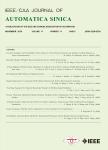Cognitive Navigation for Intelligent Mobile Robots:A Learning-Based Approach With Topological Memory Configuration
作者机构:Department of AutomationShanghai Jiao Tong UniversityShanghai 200240China MoE Key Laboratory of Artificial IntelligenceAI InstituteShanghai Jiao Tong UniversityShanghai 200240China Department of AutomationKey Laboratory of System Control and Information Processing of Ministry of EducationKey Laboratory of Marine Intelligent Equipment and System of Ministry of EducationShanghai Engineering Research Center of Intelligent Control and ManagementShanghai Jiao Tong UniversityShanghai 200240China
出 版 物:《IEEE/CAA Journal of Automatica Sinica》 (自动化学报(英文版))
年 卷 期:2024年第11卷第9期
页 面:1933-1943页
核心收录:
学科分类:081104[工学-模式识别与智能系统] 08[工学] 0811[工学-控制科学与工程]
基 金:supported in part by the National Natural Science Foundation of China (62225309 62073222 U21A20480 62361166632)
主 题:Graph neural networks(GNNs) spatial memory topological map visual navigation
摘 要:Autonomous navigation for intelligent mobile robots has gained significant attention,with a focus on enabling robots to generate reliable policies based on maintenance of spatial *** this paper,we propose a learning-based visual navigation pipeline that uses topological maps as memory *** introduce a unique online topology construction approach that fuses odometry pose estimation and perceptual similarity *** tackles the issues of topological node redundancy and incorrect edge connections,which stem from the distribution gap between the spatial and perceptual ***,we propose a differentiable graph extraction structure,the topology multi-factor transformer(TMFT).This structure utilizes graph neural networks to integrate global memory and incorporates a multi-factor attention mechanism to underscore elements closely related to relevant target cues for policy *** from photorealistic simulations on image-goal navigation tasks highlight the superior navigation performance of our proposed pipeline compared to existing memory *** validation through behavior visualization,interpretability tests,and real-world deployment further underscore the adapt-ability and efficacy of our method.



